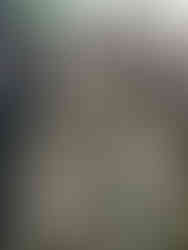Queen of Demons - The Legend of Rangda
- Shannon
- Sep 18
- 5 min read
The Witch Queen of Bali
Evoking both fear and intrigue, the Balinese divinity known as Rangda stands as a terrifying yet essential force within the island's spiritual and cultural landscape. She is more than just a monstrous figure, she is the embodiment of ultimate darkness, chaos and destruction, the shadow side of the cosmos that cannot be ignored or denied. In traditional Balinese mythology, Rangda is locked in an eternal battle against Barong, the benevolent lion-like spirit who represents the forces of good. Their mythic struggle is not simply a tale of good versus evil, but a profound reflection of the Balinese philosophy of balance, where opposites coexist and are both necessary for cosmic harmony.
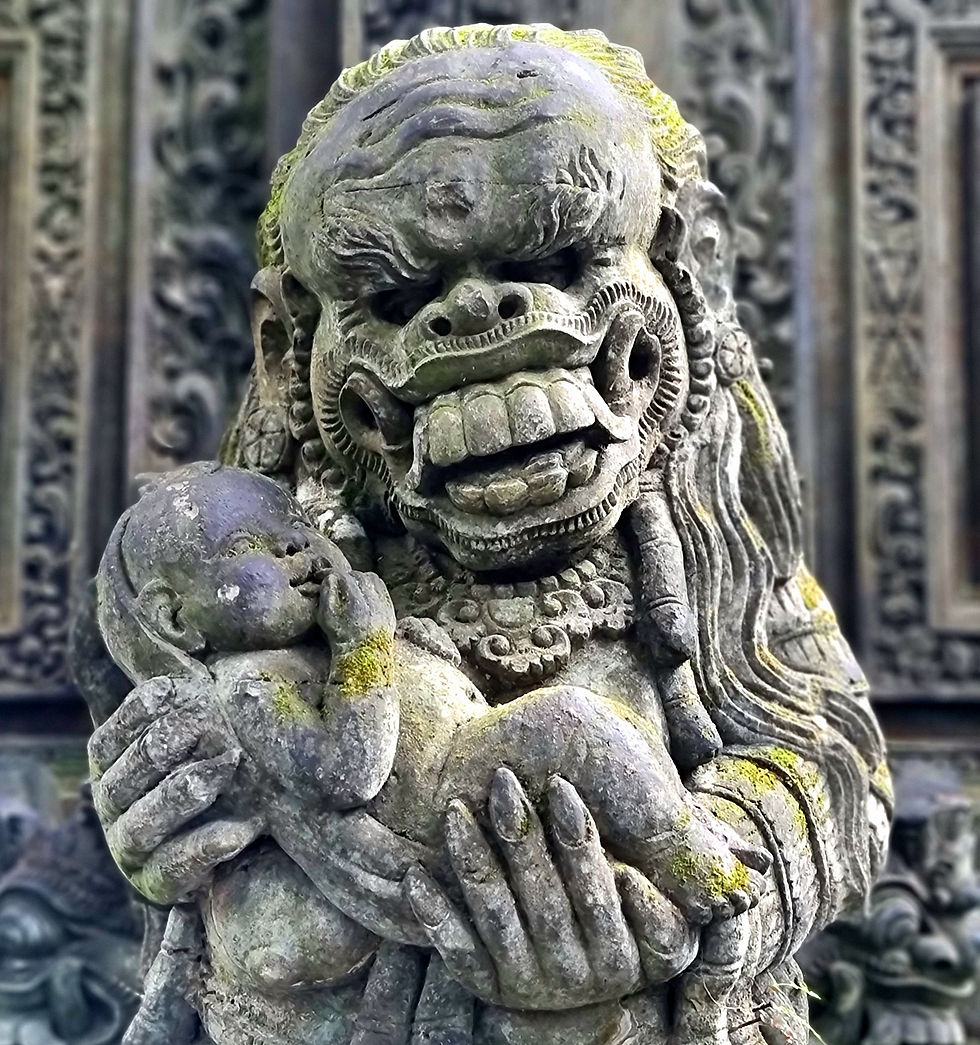
Curse Upon the Kingdom
Rangda, whose name in ancient Javanese means "the widow," is more than a terrifying figure, she embodies the raw, untamed forces of grief, vengeance and spiritual imbalance. Believed by some to be inspired by Queen Mahendradatta, a noblewoman banished for her practice of sorcery, Rangda is a tragic figure twisted by exile and humiliation. Her descent into dark magic marks her transformation from a wronged woman into a demonic force capable of conjuring plagues and commanding malevolent spirits. In temple performances across Bali, Rangda’s grotesque features, bulging eyes, wild hair and a lolling blood-red tongue, aren’t just for shock, they serve a sacred purpose. As much as she invokes dread, Rangda is also a necessary instrument of purification, drawing out evil so it can be confronted and expelled.
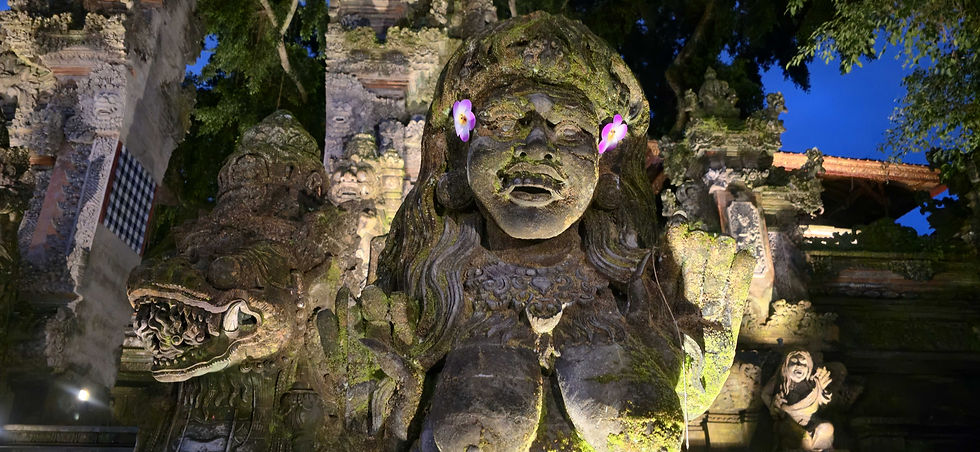
She is often depicted holding her favourite snack
Where Darkness Began - The Tale of Calon Arang
This duality becomes even more potent when Rangda is linked with the legendary witch Calon Arang, a name often used interchangeably with hers in Balinese storytelling. In some versions of the myth, Rangda is Calon Arang, a widow whose rage at the villagers who rejected her daughter led her to unleash curses and black magic upon them. Their narratives blur, fusing into a singular archetype of the scorned woman-turned-sorceress whose immense power threatens the cosmic order. The tale of Calon Arang, like that of Rangda, is a cautionary myth about the dangers of unchecked sorrow and spiritual corruption but also about the need to face darkness head on. Whether portrayed as Mahendradatta or Calon Arang, Rangda’s presence in Balinese rituals reminds worshippers that evil is not merely to be feared but understood and ritually contained.

Feminine Power, Divine Wrath and Spiritual Cleansing
For centuries, the Legend of Rangda, Bali’s Queen of Demons, has fascinated culture by embodying the eternal struggle between light and dark. According to legend, her sorcery brought widespread plague, death and spiritual decay to the land. Her transformation from a wronged woman into a monstrous force of destruction personified both the fear of unchecked feminine power and the supernatural consequences of injustice. In the climax of the tale, a powerful holy man confronted her in a dramatic battle that symbolised the struggle between chaos and order. He ultimately defeated her in her demonic form but rather than simply destroy her, he performed a ritual absolution, briefly restoring her human self before taking her life once again, an act interpreted by some as spiritual cleansing and by others as a final silencing of a woman who defied societal bounds. Rangda is also believed to share deep symbolic ties with the fierce goddesses of Hindu mythology, particularly Durga, the invincible warrior who slays demons to restore cosmic order and Kali, the wild, blood-soaked goddess of destruction and transformation. Like these deities, Rangda embodies the untamed force of feminine power, both nurturing and annihilating, protector and destroyer. Though Rangda is feared as a dark entity in Balinese lore, her mythic essence echoes the ancient truth found in Hindu cosmology, that divinity is not always gentle and that sometimes, the path to balance must first pass through chaos and fire.
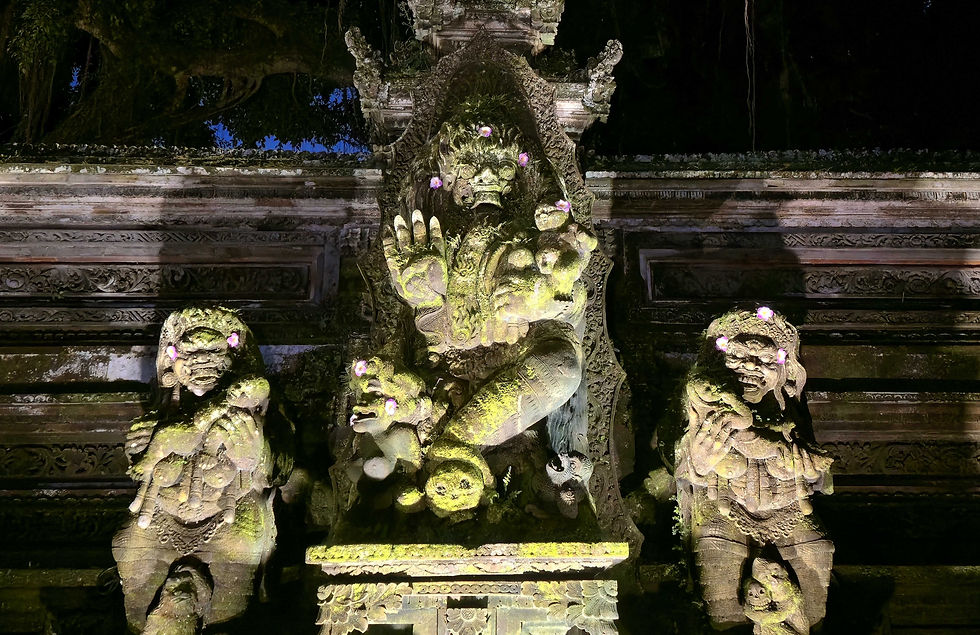
A night time display at the Pura Dalem, or Temple of Death, in Ubud
Children of the Grave - The Rise of the Leyaks
Rangda’s army of darkness is composed of the Leyaks, grotesque shapeshifters that wear human skins by day and tear free from them by night. When the sun falls, their true forms emerge, levitating, disembodied heads, eyes blazing like fire, their hair writhing in the wind like black tendrils of smoke. From the ragged neck stump dangle coils of glistening entrails, slick with bile and blood, swinging like festering chains as they hunt. They glide through the night sky with an appetite for the obscene, drawn to rot, decay and the trembling scent of fear. When they descend, they rip open graves with clawed teeth, gorging on bloated corpses, gnawing through muscle and cartilage, cracking bones like dry twigs. Their most grotesque craving, is for the blood of the unborn. Drawn to the scent of expectant mothers, they hover outside homes, whispering in foul tongues. Then, with fangs like curved needles, they tear through flesh and womb, drinking fetal blood straight from the womb, leaving behind mutilated bodies and pools of congealed gore. Disease festers in their wake. These are not merely spirits of malice, the are ritual monsters, symbols of unrestrained vengeance and the obscene power of corruption. In Balinese cosmology, they are reminders that even the sacred has a shadow and that darkness, if left uncontained, will devour the living from the inside out.
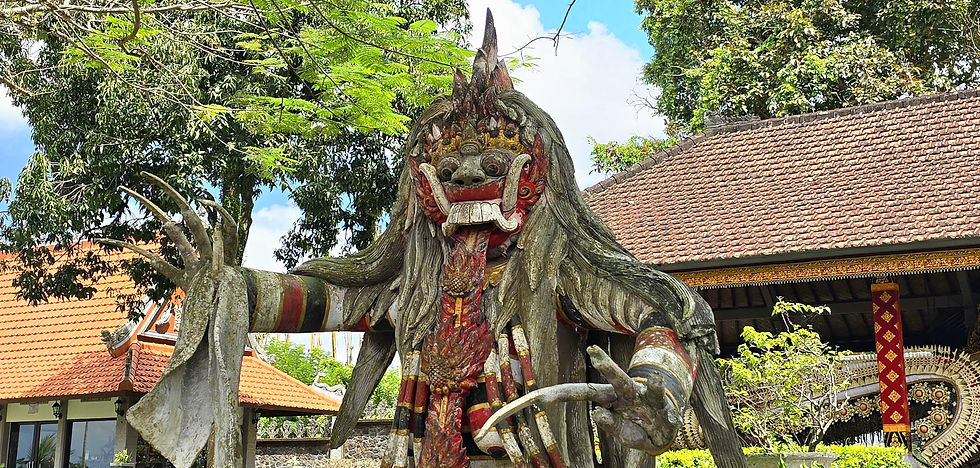
Rangda in Modern Balinese Rituals
In Balinese art and ritual performance, Rangda is portrayed in all her dreadful majesty, as a grotesque, cannibalistic sorceress, crowned the Queen of Black Magic and Mistress of the Leyaks. Her body is that of a withered, naked crone, her matted dreadlocks cascading around a face twisted with malevolence. Enormous fangs jut from her vicious mouth, which stretches wide in a fiery snarl and a serpentine tongue lolls from her lips as if tasting the terror she inspires. Her ornaments are not gold or silk but entrails, glistening, blood-slick intestines draped across her form like jewelry from hell. In many depictions, she is shown desecrating tombs, clawing at corpses and devouring infants, drunk on the blood of innocence and vengeance.
Rarung (as depicted above) is a pupil of Rangda, who has reached a high degree of proficiency in witchcraft & possesses the ability to dispose of dead bodies
The Eternal Battle
The epic confrontations between Rangda and Barong are brought vividly to life in traditional Balinese dance dramas, known as Barong dances. In these sacred enactments, elaborately costumed dancers embody the forces of good and evil. As the battle unfolds, dancers fall into deep trances possessed by ancestral spirits. Kris dancers, armed with sharp ceremonial daggers, attempt to stab themselves in a display of spiritual invincibility, yet the blades fail to pierce their flesh, protected by the power of Barong. These performances are not mere folklore but sacred acts of cosmic maintenance, where the eternal struggle between light and darkness is ritually acknowledged and rebalanced. For the Balinese, it is not victory that matters most, but the confrontation itself, a reminder that evil cannot be denied or buried, only understood, contained and kept in balance with the forces of good.

The Enduring Power of the Demon Queen
Although Rangda is widely viewed as the embodiment of evil, she paradoxically serves a protective role, acting as a vessel for all things monstrous and dark. In Balinese culture, she counteracts black magic, absorbing and defusing its malevolent power. By directly challenging those who practice evil, she forces them to confront their own dark forces, ensuring a balance between good and evil in the spiritual realm.
Thanks for reading Queen of Demons - The Legend of Rangda. Check out more awesome Balinese myths and amazing destinations here!


